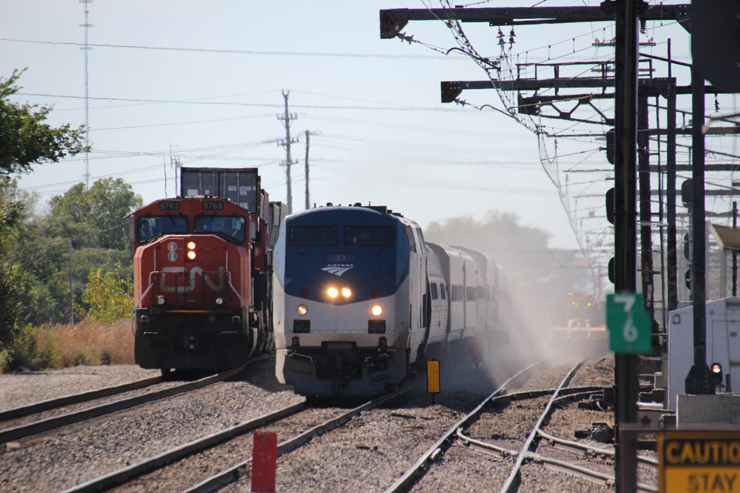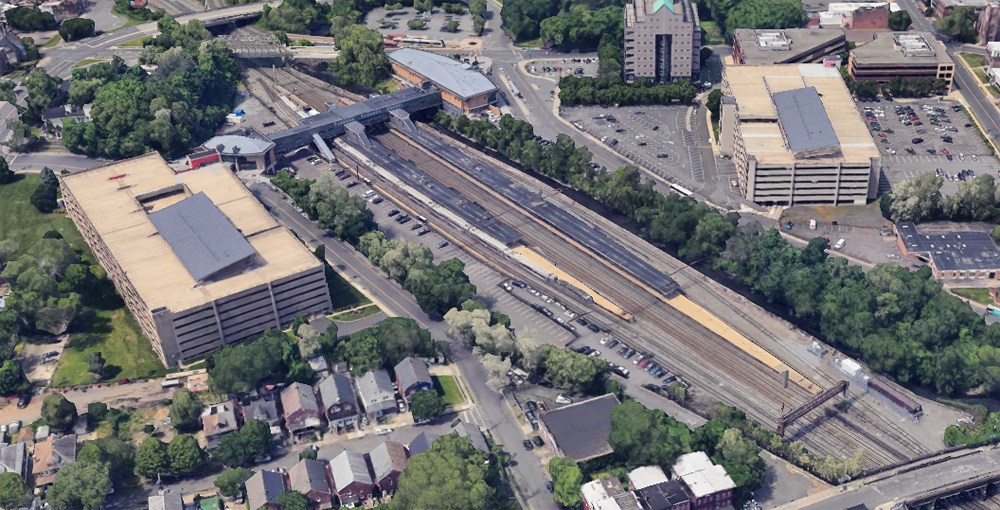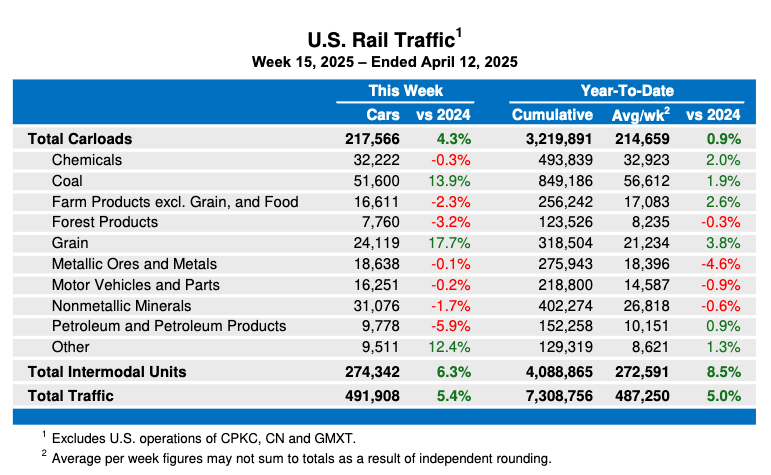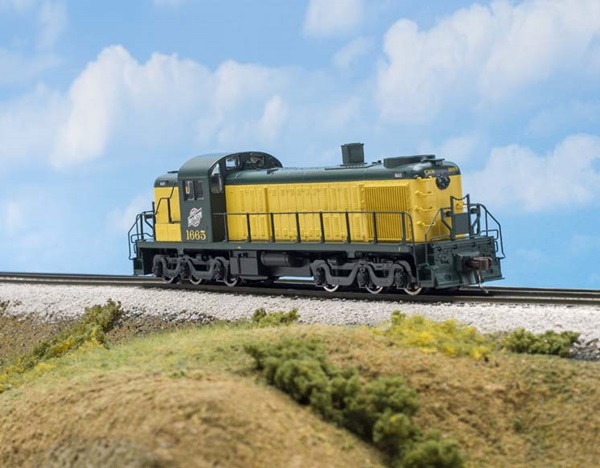
Atlas Model Railroad Co. has released a new run of HO scale Alco RSD-5 diesel locomotives in its Classic line. The six-axle road switcher features a dual-mode ESU LokSound decoder, improved tooling on the turbo exhaust stack (air- and water-cooled versions), and factory-installed and painted wire grab irons.
The prototype. Alco produced the RSD-5 from March 1952 through March 1956. During that time, 204 units were built. The bulk of the production run – 167 units – went to railroads in the United States: Atchison, Topeka & Santa Fe; Birmingham Southern; Chesapeake & Ohio; Chicago & North Western; Central of New Jersey; Milwaukee Road; Pennsylvania RR; Southern Pacific; St. Louis Southwestern (Cotton Belt); Texas & New Orleans; and Utah Ry. National Railways of Mexico (2) and Pacific RR (35) were the two non-U.S. railroads to roster the RSD-5.
Our sample is decorated as Chicago & North Western no. 1665, one of 10 RSD-5s rostered by the granger road. Units 1665 through 1667 were built in September 1953.
The remaining seven locomotives (1684 to 1690) were built in March and April 1954. Of the second batch, five (1686 through 1690) had high short hoods that housed a steam generator and dynamic brakes (the latter in units 1686 through 1688 only). The unusual appearance of the high-short-hood on the five C&NW RSD-5s earned them the nickname “hammerheads.”
The majority of C&NW’s RSD-5s were retired between July 1977 and March 1981 (no. 1687 was wrecked and scrapped in 1968). The 1684 was rebuilt into a snow plow, CNW X263000, in 1980 at Oelwein, Iowa. Though the conversion greatly changed the cab and short hood, the profile of the long hood and the trimount trucks are a couple of indicators of the plow’s RSD-5 heritage. The plow was retired by Union Pacific after it acquired the C&NW in 1995. Today the plow is part of the collection at the Boone (Iowa) Scenic Valley RR.
Number 1689 served on commercial railroads and tourist lines in Wisconsin, Maryland, and Ohio since its retirement in 1981. The locomotive, painted in C&NW colors, is currently part of the operating fleet of diesels at the Illinois Railway Museum in Union.
For a thorough history of prototype locomotives, check out Paul K. Withers article “Alco’s RSD-4 and RSD-5: The ‘Sure-Footed’ Road Switcher” in the March/April 1998 issue of Diesel Era magazine. In addition to historical information, the story also includes prototype photos and an equipment diagram.
The model. The RSD-5 has been a part of the Atlas product lineup since the mid-1980s, and many upgrades have been made to the tooling over the years. The current model consists of a one-piece sill; a body (air- and water-cooled turbo exhaust stack versions) with a separate cab; and factory-installed air horns, exhaust stack, and brake wheel. The handrails, stanchions, and uncoupling levers are flexible plastic; the grab irons are painted metal. To separate the shell from the chassis, I first removed the draft-gear boxes. Then I disengaged the tabs on the body (one in each corner) that lock into nubs on the metal chassis. I gently wiggled the shell, being careful to not damage the handrails, until it slid off the chassis.
Above the fuel tank is a five-pole skewed armature motor flanked by brass flywheels, as shown in the bottom photo on the opposite page. A printed-circuit board spans the motor and flywheels. The ESU LokSound decoder is above the rear truck; a downward-facing speaker is located over the front truck. Screw-mounted metal weights are located over both trucks. Light-emitting diodes are used to illuminate the twin-beam headlights at each end.
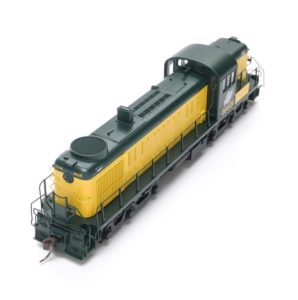
Measuring up. The Atlas Alco RSD-5 is equipped with Accumate knuckle couplers, mounted at the correct height. The blackened metal wheels are properly gauged. The six-axle unit tips the scales at 10.1 ounces. I compared the model to prototype drawings in Chicago and North Western Power: Modern Steam and Diesel 1900 to 1971 by Patrick C. Dorin (Superior Publishing Co., 1972). The major dimensions match published data. The distance over the couplers is a scale 1′-6″ long, which is typical, as model couplers are slightly oversized. The yellow and green paint was smooth and evenly applied, and the separation lines between colors were crisp. The three-color Chicago and North Western Railway ball-and-bar herald on the cab sides was correctly registered. I was really impressed by how opaque the yellow reporting marks and road numbers were on the dark green sides and ends. Making yellow pop over a dark color is no easy task.
There were a few detail discrepancies between the model and the prototype. The full-size 1665 had vertical Pyle National twin sealed-beam headlights, a multi-chime air horn on the long hood end of the cab, a mix of tall and short long hood doors, square screens instead of louvers on the long hood, and a Champion brake wheel. The details on the model’s shell more closely match those found on units operated by the Chesapeake & Ohio and Pennsylvania RR. Both of those road names were offered in previous releases.
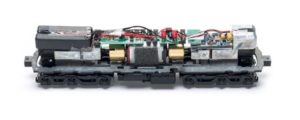
To the test track. The Atlas RSD-5 features a dual-mode ESU LokSound sound decoder, so I tested the model in both environments. For the direct-current test, I used a Bachmann power pack. The sounds came on at 8.4V. This is typical of sound-equipped units on DC. The model star-ted moving at 3.1 scale mph at 10.2V and achieved a top speed of 42 scale mph at 12V. For the Digital Command Control (DCC) testing, I used an NCE PowerCab. From the box, I couldn’t get the model to move at speed step 1 of 28. Adjusting configuration variable (CV) 2 to 5 resolved the issue. At step 1 the road switcher crawled along at 2.5 scale mph. At step 28, the model hit a top speed of 123 scale mph.
I was unable to locate a top speed for the full-size RSD-5, but the RSD-4 had a top speed of 65 mph. The speed range can be fine-tuned using CVs as spelled out in the ESU user manual, available as a free download from loksound.com. I then took the RSD-5 over to our Milwaukee, Racine & Troy staff layout to put the six-axle road locomotive through its paces. The engine navigated the model railroad’s 36″ radius curves and no. 6 turnouts without incident. With a drawbar pull of 2.56 ounces, the RSD-5 should be able to pull 36 free-rolling freight cars on straight and level track. To see what the locomotive could pull up a grade, I assembled an eastbound train at Bay Junction. The six-axle unit hauled eight 50-foot freight cars up the 3 percent grade without slipping.
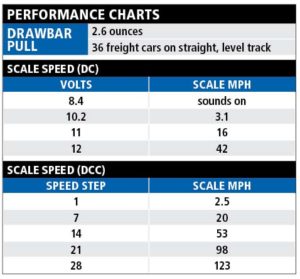
An oldie but goodie. The Alco RSD-5 has been part of the Atlas HO scale diesel lineup for more than 35 years. Continuous upgrades to the shell and mechanism, as well as the addition of a sound decoder, have kept this veteran road switcher as relevant as ever.
Price: $164.95 (direct current with 8-pin socket for Digital Command Control decoder); $274.95 (with dual-mode ESU LokSound decoder)
Manufacturer:
Atlas Model Railroad Co.
378 Florence Ave.
Hillside, NJ 07205
atlasrr.com
Era: March 1953 through 1981 (as decorated)
Road names: Chicago & North Western; Atchison, Topeka & Santa Fe (pinstripe scheme); and Southern Pacific (“black widow”). Two road numbers per scheme. Also available undecorated (water- and air-cooled exhaust versions).
Features:
Blackened metal wheels, in gauge
Body-mounted Accumate couplers, at correct height
Factory-installed and painted wire grab irons
Plastic handrails and stanchions
Weight: 10.1 ounces







